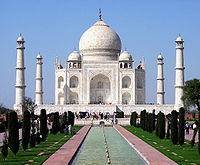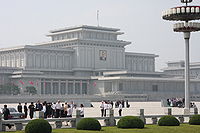- Mausoleum
-
 The interior of the Spring Valley Mausoleum in Minnesota, listed on the National Register of Historic Places.
The interior of the Spring Valley Mausoleum in Minnesota, listed on the National Register of Historic Places.
A mausoleum[1] is an external free-standing building constructed as a monument enclosing the interment space or burial chamber of a deceased person or persons. A monument without the interment is a cenotaph. A mausoleum may be considered a type of tomb or the tomb may be considered to be within the mausoleum. A Christian mausoleum sometimes includes a chapel.
Contents
Overview
The word derives from the Mausoleum of Halicarnassus (near modern-day Bodrum in Turkey), the grave of King Mausolus, the Persian satrap of Caria, whose large tomb was one of the Seven Wonders of the Ancient World.
Historically, mausolea were, and still may be, large and impressive constructions for a deceased leader or other person of importance. However, smaller mausolea soon became popular with the gentry and nobility in many countries. In the Roman Empire, these were often ranged in necropoleis or along roadsides: the via Appia Antica retains the ruins of many private mausolea for miles outside Rome. However, the practice fell out of use when Christianity became dominant.[2]
Later, mausolea became particularly popular in Europe and its colonies during the early modern and modern periods. These are usually small buildings with walls, a roof and sometimes a door for additional interments or visitor access. A single mausoleum may be permanently sealed. A mausoleum encloses a burial chamber either wholly above ground or within a burial vault below the superstructure. This contains the body or bodies, probably within sarcophagi or interment niches. Modern mausolea may also act as columbaria (a type of mausoleum for cremated remains) with additional cinerary urn niches. Mausolea may be located in a cemetery, a churchyard or on private land.
In the United States, the term may be used for a burial vault below a larger facility, such as a church. The Cathedral of Our Lady of the Angels in Los Angeles, California, for example, has 6,000 sepulchral and cinerary urn spaces for interments in the lower level of the building. It is known as the "crypt mausoleum". In 2010, a woman was discovered to have exhumed her deceased husband and twin sister, and was keeping the remains in her Wyalusing, Pennsylvania home. Authorities advised that the only legal way for her to keep the remains on her premises, is to erect a mausoleum.[3]
Notable mausolea
Main article: List of mausoleaAfrica
- The Dr. John Garang De Mabior mausoleum in Juba, South Sudan.
- The Mastaba
- The pyramids of ancient Egypt and Nubia are also types of mausolea.
- Royal Mausoleum of Mauretania
- Al Hussein Mosque, Cairo – a Holy Shrine and Mausoleum, where it is believed by some that the head of the Islamic prophet Muhammad's grandson is buried.
- Qalawun Mausoleum is the Mausoleum of Qalawun, Located in Cairo, Egypt, it was regarded by scholars as the second most beautiful medieval mausoleum ever to be built.
- Dr. Bingu Wamutarika , President of Malawi built a mausoleum for his late first wife in 2010. It has two graves,one has been used. It is not clear who is going to rest in the other one.
Asia, eastern
- National Chiang Kai-shek Memorial Hall at Taipei
- Taj Mahal at Agra, India
- The Shrine of the Báb and the Shrine of Bahá'u'lláh in Haifa and Acre, Israel, respectively.
- Mausoleum of the First Qin Emperor biggest underground mausoleum
- The pyramids of ancient China are also types of mausolea.
- Qianling Mausoleum in China, houses the remains of Emperor Gaozong of Tang and the ruling Empress Wu Zetian, along with 17 others in auxiliary tombs.
- Mausoleum of Genghis Khan in Ordos City, Inner Mongolia.
- Tomb of Jahangir at Shahdara, near Lahore, Pakistan.
- Mazar-e-Quaid at Karachi, Pakistan
- Data Durbar at Lahore, Pakistan
- Ho Chi Minh Mausoleum
- Kumsusan Memorial Palace or Kim Il-sung Mausoleum, Pyongyang, Democratic People's Republic of Korea (North Korea)
- Mausoleum of Mao Zedong
- Quezon Memorial, in Quezon City, Philippines, houses the remains of Philippine President Manuel Quezon and his wife Aurora.
- Astana Giribangun Suharto family complex in traditional Javanese architectural style in Karanganyar, Central Java
- Imogiri complex in Imogiri, Central Java is the cemetery for Mataram royals and the Hamengkubuwana Royals of Yogyakarta and Pakubuwono of Surakarta
Asia, western
- Mausoleum of Maussollos at Halicarnassus
- Mausoleum of Cyrus the Great in Pasargadae, Iran.
- Naqsh-e Rustam at Persepolis, Tombs of Persian Achaemenid kings (522-486 BCE).
- Anitkabir mausoleum of Ataturk the founder of the Republic of Turkey at Ankara, Turkey
- Imam Husayn Mosque, Karbala – according to Shī‘ah belief,[4] the head and body of Husayn ibn Ali, along with all others who fell at the Battle of Karbala are buried here.
- Imam Reza shrine in Mashhad, Iran
- The Mausoleum of Khomeini in Tehran, Iran
Europe
- Hamilton Mausoleum at Hamilton in Scotland, UK
- Royal Mausoleum and the Duchess of Kent's Mausoleum at Frogmore, England
- Lenin's Mausoleum in Moscow, Russia.
- Mausoleum of Augustus in Rome, Italy.
- Mausoleum of Adrian in Rome, Italy
- Mausoleum of Theodoric in Ravenna, Italy
- Mausoleum of Galla Placidia in Ravenna, Italy
North America
- Henry Flagler's Mausoleum in St. Augustine, Florida
- Grant's Tomb, New York City – loosely based on Mausolos' original mausoleum.
- Abraham Lincoln's tomb in Springfield, Illinois
- Miles Mausoleum in Arlington National Cemetery
- Queen of Heaven Mausoleum in Queen of Heaven Cemetery, Hillside, Illinois
- Rose Chapel Mausoleum in Roseland Park Cemetery, Berkley, Michigan
Oceania
- Royal Mausoleum in Honolulu, Hawaii where the members of the Kamehameha and Kalākaua dynasties are interred.
Latin America
- El Ángel Victory column and mausoleum to the heroes of the Mexican Independence in Mexico City, Mexico.
- Obelisk of São Paulo mausoleum to the heroes of Constitutionalist Revolution in São Paulo City, São Paulo, Brazil.
- Chico Xavier mausoleum in Uberaba, Minas Gerais, Brazil.
See also
Footnotes
- ^ The plurals mausoleums and mausolea are equally correct in English.
- ^ Paul Veyne, in A History of Private Life: I. From Pagan Rome to Byzantium, Veyne, ed. (Harvard University Press) 1987:416.
- ^ Michael Rubinkam (04 January 2011). "Pa. widow builds vault, could get corpses back". Associated Press. http://www.todayonline.com/BreakingNews/EDC110104-0000471/Pa,-widow-builds-vault,-could-get-corpses-back. Retrieved 10 January 2011.
- ^ al-Qummi, Ja'far ibn Qūlawayh (2008). Kāmil al-Ziyārāt. trans. Sayyid Mohsen al-Husaini al-Mīlāni. Shiabooks.ca Press. p. 63.
External links
Categories:- Mausoleums
Wikimedia Foundation. 2010.




